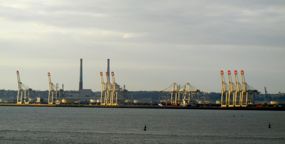 |
Le Havre, Normandy, France | |
| This large port in Normandy is a busy international shipping center with a long history. | ||
|
|
|
Le Havre, at the mouth of the River Seine 196 km (122 miles) northwest of Paris (map), is France's second largest port, after Marseilles. It also holds the dubious distinction of having been the most destroyed port in France during World War II. It suffered significant damage on D-Day and the Battle of Normandy, with 80% of the city and the entire port area destroyed. Le Havre was rebuilt from 1946 to 1964, under the direction of Auguste Perret, who has been described as a "poet in concrete." Today Le Havre stands as a major port and the largest city in Normandy. In 2005, Le Havre was named a UNESCO World Heritage site, the first 20th century urban site in Europe to be so designated. It is known for its open public spaces and access to the water. Located on the right bank of the Seine and the English Channel, Le Havre has long welcomed luxury liners, cruise ships, commercial shipping and ferryboats from southern England. More... But it also has museums and a rich cultural life. Many impressionist painters worked in Le Havre and were inspired by its light and sea views. Historically, the town was started by King François Ier in 1517. Built on the site of the Church of Notre-Dame-de-Grâce, it was originally called Le Hable de Grâce. That was later shortened to Le Havre, the Harbor or Port. Le Havre is now connected to Honfleur and the south via the Pont de Normandie, which opened in 2005.
|
|
Above, The port of Le Havre,
|

